Laboratories are the epicenter of innovation and scientific discovery. No matter your field—be it biotechnology, chemistry, or any other—the design of your laboratory furniture has an immense effect on its results, and vice versa. Here we explore current trends in designing state-of-the-art labs offering cutting-edge functionality while remaining visually pleasing.
Lab Furniture Has Its Benefits
Laboratory furniture is more than tables and chairs; it plays an essential part of research processes. Appropriately designed furniture enhances productivity, safety, and organization in the lab, helping scientists work efficiently while being comfortable during their studies.
Key Considerations in Selecting Laboratory Furniture
Ergonomics and Comfort
Gone are the days of uncomfortable lab stools and cramped workspaces. Ergonomics has now taken top priority when designing lab furniture. Adjustable chairs, height-adjustable workstations, and other features designed to alleviate fatigue or repetitive strain injuries among lab staff are becoming standard features now.
Materials and Durability
Laboratories can be challenging environments. Chemicals, heat, and rigorous use all contribute to an unsafe working environment for lab personnel and the furniture they need for this environment. As such, modern laboratory furniture often features durable and chemical-resistant materials like stainless steel, chemical-resistant laminates, and epoxy resin for construction that provide easy clean-up while remaining chemical- and long-term-resistant.
Safety Features
Laboratory furniture must meet safety standards to reduce risks in an efficient laboratory setting, with features like rounded edges and corners and chemical-resistant surfaces designed to lower accident risks, as well as emergency eyewash stations and fireproof materials frequently integrated into its design.
Trends in Lab Furniture Design
Modular Lab Furniture
Modern laboratory design emphasizes adaptability. Modular lab furniture makes this task simpler by offering users the freedom to change the layout as their needs shift, saving both time and money while improving efficiency.
Sustainable and Eco-Friendly Options
Sustainability has no longer become an afterthought in laboratories; increasingly, they’re opting for eco-friendly lab furniture like recycled or sustainable material furniture, energy-saving lighting options, and other environmentally conscious choices. Going green is no longer just an optional trend; it is vital for future success!
Smart Lab Furniture
Technology has revolutionized lab work. Smart lab furniture incorporates technology for data collection, analysis, and automation into furniture to increase data accuracy and lab efficiency. For instance, smart benches may come equipped with power outlets, USB ports, or data connections so researchers can perform experiments more easily while recording results more reliably.
Custom-Designed Laboratory Furniture Solutions
Not all laboratories are the same, and a one-size-fits-all approach to lab furniture rarely meets everyone’s unique requirements. Customized solutions have grown increasingly popular as labs look for ways to optimize space and functionality within their spaces. Whether specialized workbenches, storage solutions, or tailored furniture solutions may be desired by an institution, customization could be your answer.
Budget-Friendly Lab Furniture for Small Labs
High-quality lab furniture doesn’t have to come at an astronomical price tag; there are budget-conscious solutions readily available that provide quality and functionality without breaking the bank. These solutions are especially advantageous for smaller labs or startups looking to maximize resources efficiently.
How Lab Furniture Impacts Productivity
Efficiency and productivity lie at the center of any laboratory’s success. Properly designed lab furniture streamlines workflow, decreases downtime, increases collaboration among researchers, and fosters productivity; purchasing quality pieces shouldn’t simply be seen as a convenience but as an investment in productivity.
Conclusion
Overall, designing an advanced laboratory requires careful consideration when selecting lab furniture. From ergonomics and material selections to design trends and safety features, finding furniture suitable for every aspect of lab operations, such as ergonomics, is vital in creating an innovative work space characterized by productivity, safety, and cutting-edge features. In future lab environments, flexible furniture solutions that meet each scientific discipline’s individual requirements are necessary for creating productive, safe work spaces.
So whether you are a researcher, lab manager, or involved with lab design, remember that furniture selection will have an enormous effect on how effectively and successfully your research lab functions and produces research. Stay abreast of trends; invest in ergonomic and sustainable options; and create an atmosphere that fosters innovation and discovery within your lab space.
FAQs
1. How can I ensure my lab furniture is eco-friendly?
To ensure eco-friendliness, choose lab furniture made from sustainable materials, look for eco-certifications, and consider energy-efficient lighting and equipment.
2. What are the latest trends in lab furniture design?
The latest trends include modular furniture, eco-friendly options, and smart lab furniture that integrates technology.
3. Is ergonomic lab furniture worth the investment?
Yes, ergonomic lab furniture is worth the investment as it promotes researcher comfort and reduces the risk of injuries.



